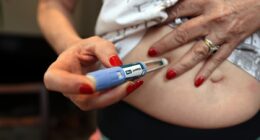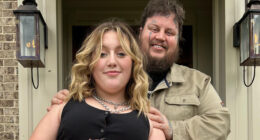Sure, this may sound kinda gross when you visualize it… but is it actually that bad? Keep reading to see just how icky and even risky eating a post-blowout slice of birthday cake can be—as well as how much spit and bacteria are typically transmitted.
So… how much spit can you expect on a birthday cake?
According to Trevor Craig, a food safety expert and the corporate director of technical training and consulting at Microbac Laboratories, the exact amount of spit transferred as someone blows out candles will vary. Contributing factors can range from what the person recently ate or drank, the force of the exhalation, how they’re feeling, or simply having more active salivary glands.
Simply put, Craig says that the question is hard to answer with a precise numerical value. “Until recently, there weren’t a lot of studies on this or how your spit gets aerosolized when talking,” he shares. Nonetheless, “The formation of thin layers of fluids in the lungs, upper airways, and saliva in the mouth are all broken and expelled when you talk or blow air out of your mouth. Either way, it’s a lot more aerosolized liquid coming out of you than you think.”
“The formation of thin layers of fluids in the lungs, upper airways, and saliva in the mouth are all broken and expelled when you talk or blow air out of your mouth. Either way, it’s a lot more aerosolized liquid coming out of you than you think.”
Spit aside, how bad is the transmission of bacteria when blowing out birthday candles?
When candles are blown out, spit is inevitably transferred… but also bacteria. “There are studies that show media plates designed for growth of bacteria exposed to someone talking and a control, and the change in bacterial growth is astounding,” Craig shares. “They have done the same with food items, and it’s hundreds of percentages higher after someone blows on it.”
Researchers have even tested the potential spread of bacteria from blowing out birthday candles. In a 2017 study, researchers spread icing on a sheet of foil, which was layered over a styrofoam base, before placing birthday candles on top. Lucky participants ate some pizza (it was a birthday simulation, after all), then proceeded to blow out candles. The result? The amount of bacteria measured was 1,400 percent higher than the control sheet of icing sans candle blowout.
In all sincerity, I’d hate to be the person to deliver info that will never let you look at a slice of birthday cake the same way again. Yes, all this talk about spit loads and bacteria transfers sounds far from appetizing. But before you panic and swear off birthday cake forever, Craig advises that we all take a step back to put things into perspective. “Our bodies are full of bacteria and our mouth has a lot of it in there, but not all bacteria is going to make you sick,” he explains. “In fact, we have a lot of good bacteria in our bodies that are important to how we live and survive.”
READ RELATED: Coffee Fruit Nutrition vs. Coffee Beans: How Do They Compare?
With that, he gives us the green light to avoid thinking about it too hard. We’re talking about cake after all; not even a food safety expert is about to get in your way of enjoying it.
For reference, we can still transmit bacteria each and every day from simply talking. If you’re booed up, kissing will inevitably yield the same effect. But it’s not like you’ll automatically start to fear talking or kissing because of this, right? “It’s all gross if you think about it too hard,” Craig notes. With that, he gives us the green light to avoid thinking about it too hard. We’re talking about cake after all; not even a food safety expert is about to get in your way of enjoying it.
The takeaway
Unless the person blowing out birthday candles is under the weather or “spittier” than average, both the ick and risk factors are pretty minimal on the cake front. If you’re the one who’s celebrating—or perhaps your child is—you can also arrange to have one mini birthday cake or cupcake to blow out candles to your heart’s content, while keeping another spit-free cake on hand for everyone else.
All things considered, Craig says the whole scenario doesn’t concern him—and the same should largely go for the rest of us. “It’s not terribly high risk in most cases,” he confirms. “However, I did think about it more during the height of COVID or during flu outbreaks, [and] when I’m trying to avoid getting sick during vacation or when I’m around immunocompromised people.” You may also want to think twice under similar circumstances.
Lastly, while a post-blowout birthday cake at the actual gathering gets his A-okay, leftovers could harbor even more bacteria over time. “That bacteria will just keep growing and populating on that cake; that makes the risk on it higher and most likely shortens the cake’s shelf life,” Craig explains. While this risk increases, it’s still pretty low, but you can always err on the side of caution if it’ll make you stress less. Craig hints that it’s safer to accept that second slice of cake at the party instead of taking it home—so heed the food safety expert’s advice and allow yourself to dig back in.
Well+Good articles reference scientific, reliable, recent, robust studies to back up the information we share. You can trust us along your wellness journey.
Source


